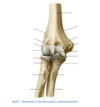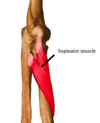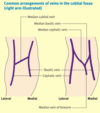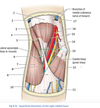17 - Elbow Joint Flashcards
(53 cards)
Label this diagram with the tendons and ligaments of the elbow joint.


Label this diagram of the anterior elbow joint.


Label this diagram of the cubital fossa.


Label this diagram of the anterior forearm muscles.


Label this diagram of the tendons at the wrist.


What articulations does the elbow joint consist of?
- Humeroulnar: trochlea of humerus and trochlear/sigmoid notch of ulnar
- Humeroradial: capitellum of humerus and raidal head

Label this diagram of the elbow joint and what inserts on the medial and lateral epicondyles?

Medial: Attachment for flexor-pronator group in anterior forearm
Lateral: Attachment for extensor group in the posterior forearn

Label this diagram and state what inserts onto the radial tuberosity?

Biceps Brachii

Label this diagram of the elbow joint and state what inserts onto the olecranon?

Triceps brachii

What type of joint is the elbow joint and what ligaments hold the joint together?
- Synovial joint with joint capsule
- Radial collateral: lateral epicondyle and annular ligament of radius, keeping head of the radius and the capitellum in close association during supination and pronation
- Ulnar collateral: triangle from medial epicondyle to coronois and olecranon
- Annular: stabilises proximal radioulnar joint as forms a collar round radial had so can rotate (pivot joint)

What are the three bands of the ulnar collateral ligament?
- Anterior: Strongest
- Posterior: Weak
- Oblique/Inferior: deepends the socket for the trochlea of the humerus

What movement is the elbow joint capable of and what muscles perform these movements?
- Flexion: brachialis, biceps brachii, brachioradialis and weak extensors are those originating from medial epicondyle of humerus
- Extension: triceps brachii, anconeus and muscles from common origin on lateral epicondyle are weak extensors

What is the carrying angle and the function of it?
- In full extension ulna makes valgus angle with humerus
- 5-10 degrees male/ 10-15 degrees female
- Allows forearm to clear hips in swinging movements of walking

What is an excess carrying angle called or a carry angle that deviates towardsthe body?
Cubitus Valgus = excessive
Cubitus Varus = towards

What provides stability to the elbow?
- Ligaments
- Surrounding muscles
- Bones
What are the important bursa of the elbow and what is their function?
- Subcutaneous Olecranon Bursa: overly the olecranon in subcutaneous CT.
- Subtendinosus Bursa: between triceps tendon and tip of olecranon
Reduce friction between bone and skin or between tendon and bone during movement

What joint does pronation and supination occur and what muscles are involved?
- Proximal and distal radio-ulnar joints
- Pronation: pronator teres and pronator quadratus
- Supination: supinator or biceps brachii when there is resistance

What is the anatomy of the distal radioulnar joint?
- Pivot joint where ulnar notch of radius rotates anteriorly around the head of the ulnar
- Triangular Fibrocartilage Complex binds the radius and the ulnar together but separates DRUJ from wrist

What happens within the annular ligament?
Radial head rotates within it
What are the joints connecting the radius and ulnar and describe the odd one in detail.
- Proximal and distal radioulnar joints
- Interosseous membrane: fibrous joint with fibres running diagonally from radius proximally to ulna more distally. Keeps bones together during pro and supination and prevents proximal displacement of radius when FOOSH

What are the muscles of the anterior forearm and what are the layers?
- Superficial: PT, FCR, PL, FRU (Pass Fail Pass Fail)
- Intermediate: FDS
- Deep: FDP, FPL, PQ
4 - 1= 3

What are the superficial muscles of the anterior forearm and what are they inverted by, and where do they originate from?
Median nerve EXCEPT for FCU which is Ulnar

What movements can each anterior compartment of the forearm carry out, and what are they all innervated by?
All innervated by median apart from FCU and FDP(medial part)

What are all the origins, insertions, actions and innervations of the superficial muscles of the anterior forearm?

































